
The Brassicales are an order of flowering plants, belonging to the eurosids II group of dicotyledons under the APG II system. One character common to many members of the order is the production of glucosinolate compounds. Most systems of classification have included this order, although sometimes under the name Capparales.
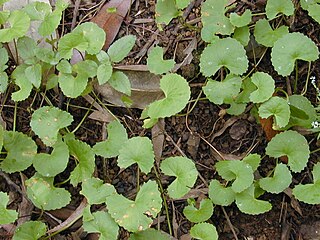
Centella is a genus of 53 species of flowering plants in the subfamily Mackinlayoideae. The genus is sometimes placed in family Araliaceae; however, recent studies utilising molecular data place Centella within Apiaceae.
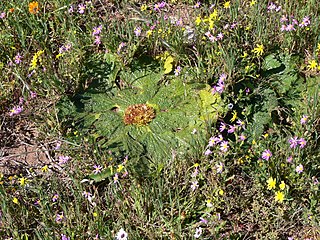
Arctopus is a genus of flowering plant in the Apiaceae, with 3 species. It is endemic to southern Africa. The genus name means "bears foot" but it was used in Khoi-San medicine and adopted by the early settlers who used the Afrikaans name of sieketroos. They are atypical members of the Apiaceae with the leaves growing flat on the ground and are dioecious, having separate male and female plants.

Passerina is a genus in the plant family Thymelaeaceae. They are ericoid bushes growing largely in fynbos and other Southern African scrub habitats.

Gymnosporia is an Old World genus of plants, that comprise suffrutices, shrubs and trees. It was formerly considered congeneric with Maytenus, but more recent investigations separated it based on the presence of achyblasts and spines, alternate leaves or fascicles of leaves, an inflorescence that forms a dichasium, mostly unisexual flowers, and fruit forming a dehiscent capsule, with an aril on the seed.
Abraham Erasmus van Wyk, also known as Braam van Wyk is a South African plant taxonomist. He has been responsible for the training of a significant percentage of the active plant taxonomists in South Africa and has also produced the first electronic application (app) for the identification of trees in southern Africa.

Ehretia is a genus of flowering plants in the borage family, Boraginaceae. It contains about 50 species. The generic name honors German botanical illustrator Georg Dionysius Ehret (1708–1770).
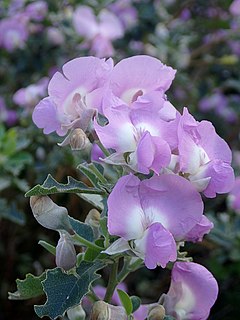
Podalyria is a genus of flowering plants in the legume family, Fabaceae. It belongs to the subfamily Faboideae. The genus is endemic to South Africa.
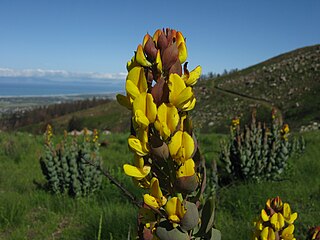
Rafnia is a genus of flowering plants in the legume family, Fabaceae. It belongs to the sub family Faboideae.

Apodytes is a genus of flowering plants in the family Metteniusaceae. It was formerly either unplaced as to family or placed in the family Icacinaceae. It consists of about 8 species of evergreen trees, from tropical northeastern Australia, New Caledonia, Africa and Asia. The exact number of species has been revised from 3 to 8, according to The Plant List.
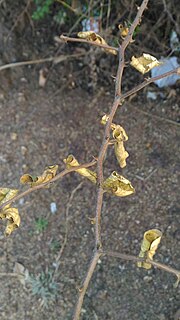
In plant morphology, thorns, spines, and prickles, and in general spinose structures, are hard, rigid extensions or modifications of leaves, roots, stems or buds with sharp, stiff ends, and generally serve the same function: physically deterring animals from eating the plant material.
Rolf Martin Theodor Dahlgren was a Swedish-Danish botanist and professor at the University of Copenhagen from 1973 to his death.

Xiphotheca is a genus of flowering plants in the legume family, Fabaceae. It belongs to the sub family Faboideae. The name of the genus is a compound of Ancient Greek ξίφος (ksíphos), which means "sword", and θήκη (thēkē) which can mean "box" or "sheath"—a reference to the shape of the legume pods. Members of this genus can be distinguished by:
"(1) the presence of bracteoles in most species; (2) the fusion of the bracts with the base of the pedicel; (3) the laterally compressed pods; and (4) the accumulation of anabasine as a major alkaloid."
Calobota is a genus of flowering plants in the legume family, Fabaceae. It belongs to the sub family Faboideae.
Wiborgiella is a genus of flowering plants in the legume family, Fabaceae. It belongs to the sub family Faboideae.

Marie Prins is a South African botanist.

Tavaresia is a genus of plants in the family Apocynaceae, first described as a genus in 1902. It is native to southern Africa.
- Tavaresia angolensisWelw. - Angola
- Tavaresia barklyi(Dyer) N.E.Br. - South Africa
- Tavaresia grandifloraBerger - South Africa
- Tavaresia meintjesiiR.A. Dyer - Limpopo
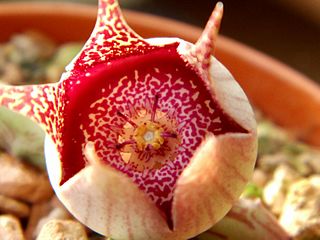
Orbeanthus is a genus of flowering plants of the family Apocynaceae, first described as a genus in 1978. It is native to South Africa.
- Orbeanthus conjunctus(White & Sloane) L.C. Leach - South Africa
- Orbeanthus hardyi(R.A. Dyer) L.C. Leach - South Africa

Excoecaria simii, the forest pepper-seed or forest pepper-seed bush, is a species of flowering plant in the family Euphorbiaceae. It is endemic to South Africa, in forests of KwaZulu-Natal and Eastern Cape.
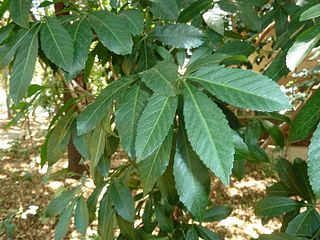
Allophylus natalensis, commonly known as the dune false crowberry or dune false currant, is a species of plant in the genus Allophylus endemic to south-eastern Africa.
















